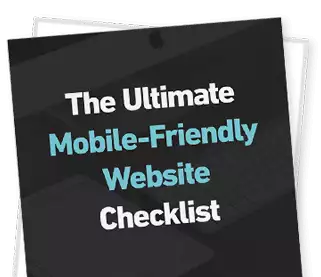
There are many common, easily avoidable business web design mistakes that can be fatal to your online lead generation and customer acquisition.
I see them all the time.
A poorly designed and structured website that doesn’t look, feel and function in the best way possible can negatively impact your businesses bottom line.
In order to achieve an effective business web design and increase online lead generation and sales it’s essential to follow good design and online marketing principles…
Doing so will ensure that your site delivers clear, effective information and messaging, and will make it easy for your visitors to take a desired action and become your customer.
Optimising and designing your site correctly can absolutely increase the number of qualified leads and sales you acquire. If you do things right, you can easily increase leads and sales from the same number of site visitors.
But to do so, it essential that you avoid committing the following web design mistakes…
Table of Contents
1) No clear goal
The first thing you should do before building any new website is to establish a clear goal, or goals, that you want it to achieve.
Ideally the website and each page will only have one. But the less the better.
Choices only lead to confusion and confusion leads to inaction.
What is the end result, the objective that you need your website to deliver? Maybe you want visitors to fill out your opt-in form. Perhaps you need them to subscribe to your email newsletter. Or perhaps you want them to dial that number you’ll be placing on every page.
Whatever it is, be sure it’s clear.
Clarify specific action(s) that you want your website visitor to take – to yourself, to your team and to your Web Designer. Eliminate as much choice and clutter as possible and aim to design each page around a single goal.
By doing so, your entire website, as well as every page in it, will have a clear purpose. Your entire site and every page should be designed to facilitate this goal. Every button or colour scheme or piece of content on your site will naturally be leaning toward the achievement of that specific goal.
Clarity of focus will help you to drive your visitors towards a specific action and lead to increased conversations and sales for your business.
2) Bad copywriting and messaging
The text you place on every page influences how both search engines and real humans will find and judge your website.
Make sure your copy is clear, persuasive and easy to understand. Package it in a way that’s concise and easy to scan. Use bullet points, write in short sentences and paragraphs, and don’t drown the reader in jargon.
Use headlines and sub-headings wisely to call out to your audience, explain benefits and compel visitors to read further. Don’t waste them with weak messaging that focuses solely on you.
Structure your content in a way that it will answer the questions of your target market in the simplest, most efficient manner. And don’t just deliver information and rattle off facts and stats.
Make your message compelling, personal and unique. Talk like a real person and let your brand’s voice and personality shine through in what you (or your copywriters) publish.
3) Poor user experience
Make sure your website does not belong to the huge number of websites today that are still committing these basic usability errors:
- The text on your page is hard to read because of the wrong size, font, colour, style or background
- Too much clutter and information overload
- Inconsistent or illogical layout
- Confusing navigation
- Dated aesthetics
- Cookie cutter website themes
- Non mobile responsive web design
People have become increasingly sophisticated and discriminating when it comes to consuming web content. They know what they want and they have solid expectations. If users don’t easily find what they want from your website, it will be very easy for them to leave and not come back again.
Make sure your website usability is high so that your users visits are positive and worthwhile.

Use simple tactics in this free website checklist to fix your leaky website or avoid expensive mistakes before you start
Yes, Send My FREE Checklist4) Lack of social proof
While your website can help you have meaningful conversations with your market, sometimes it pays to keep quiet and let others do the talking for you.
When another person vouches for you, especially if that person is someone others trust or look up to, it will positively impact the way your target customers see your business.
There are a number of ways you can provide social proof on your website, for example…
- Publish customer reviews and ratings
- Display your social media like and share numbers
- Display trust symbols, such as payment certificates and logos
- Post third party video testimonials
- Highlight endorsements from authoritative organisations
- Publish PR and media mentions
- Display the logos of clients who you have successful completed work for
- Publish successful, results driven case studies
I’m sure you can think of other creative ways to add social proof. Start curating it now so you can let others do the selling for you.
5) No clear calls-to-action
This ties in with point 2.
What do you want your website to achieve? What do you want your visitors to do? Sign up for your newsletter? Buy your product? Call your sales team?
Whatever it is, ask for the next step with a clear call to action.
Don’t just assume visitors can read you mind. Tell them what to do next.
State it using clear, concise and compelling terms. Do it in a firm but a loving way, much like a friend or family member would do if you were hurt and refusing to for help.
In a situation like this you wouldn’t assume or ask nicely, you’d say something like..
“Get to the hospital now!” or “I’m driving you to the hospital now”.
And in terms of your website calls-to-action it should be no different. You should use language and words to the same effect, such as…
“Buy now”, “Download your FREE guide now” or “Click here to contact Stuart now”.
…and so on. You get the idea.
Also be sure to use special graphical elements such as a typeface, button colour or strategic layout in order to highlight your call to action and make it stand out.
What web design mistakes are you committing?
Many businesses are still making costly web design mistakes and wasting online lead generation opportunities…
Don’t let your’s be one of them:
Take time to rectify your existing web design mistakes or start your new and effective website design now!
Is your business committing any of these web design mistakes? Have you spotted any of these mistakes else where? What do you think is the biggest or most common mistake?
Leave your thoughts and questions in the comments below…


